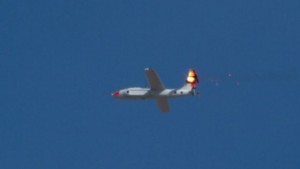It was 5-0 at the US Army’s White Sands Missile Range in New Mexico as a Lockheed Martin prototype laser weapon system shot down five unmanned drones with a 100 percent success rate. The August test of the Advanced Test High Energy Asset (ATHENA) system against five Outlaw drones was designed to demonstrate how the system’s advanced beam control technology and a solid-state fiber laser could decisively destroy unmanned aerial threats.
In a video released by Lockheed, the transportable, ground-based ATHENA system shot down the five 10.8-ft (3.3-m) wingspan Outlaws by focusing its 30 kW Accelerated Laser Demonstration Initiative (ALADIN) laser at the aircraft’s stern control surfaces until they burned off, sending the drones crashing into the desert floor.
ATHENA is a test-bed, single-mode laser system that’s based on the company’s Area Defense Anti-Munitions (ADAM) laser weapon system which uses a process that the company calls Spectrum Beam Combining. This consists of fiber laser modules where the active gain medium are made of an optical fiber doped with a rare-earth element like erbium, ytterbium, or neodymium. The optical fibers are flexible, so the laser can be thousands of meters long for greater gain, while taking up very little space because it can be coiled like a rope.
“The tests at White Sands against aerial targets validated our lethality models and replicated the results we’ve seen against static targets at our own test range,” says Keoki Jackson, Lockheed Martin’s Chief Technology Officer. “As we mature the technology behind laser weapon systems, we’re making the entire system more effective and moving closer to a laser weapon that will provide greater protection to our warfighters by taking on more sophisticated threats from a longer range.”
Lockheed Martin and the US Army Space and Missile Defense Command is currently conducting reviews of the test data to help refine the system, produce better model predictions, and improve future laser systems.
The video below shows ATHENA in action.
Source: newatlas
Ask me anything
Explore related questions

